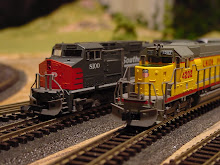After seeing the DCC-equipped consolidation in action, I am totally hooked on DCC. Once you see a DCC-equipped loco on a DCC layout, you cannot stand the whine an analog loco makes on the DCC layout. So, the next obvious step is wiring all my locos with a decoder. But, first I gotta test the decoders with this LT-1 test kit that Digitrax supplies. Let’s open it up.
O-kay. This is what came out of the package. What do I do with the resistor thingie? How do I test the decoder. Aah, there it is, a wiring chart.
Well, just to test one decoder, I need to twist six sets of wires together. Sheesh, there’s got to be an easier way. Alligator clips? Naa, too bulky. Terminal strips? Naa, takes too long. Hmm. I need something that’ll make it simple to plug in a decoder. Aah! What about one of these thingies?
So, I decided to solder the rail feeds to two of the slots on this spring-terminal (apparently that’s what they’re called). Then I soldered the black/green wires from the LT1 harness to the third slot. Finally the red/yellow wires from the harness to the fourth slot. This is what it looked like after the soldering was done.
The idea was to shove all of this in a box. Only two wires would come out of the box and connect to the rail feeds on the booster. Well, all is good, but I also wanted to be able to test loconet cables, which meant the RJ-15 jack needed to be accessible from outside the box. So, the LT1 harness needed to go out of the box and plug back in. Like so:
This is what it looked like with the wires all tucked in:
And this is what the final thing looked like after I glued the top:
Did you catch that? Glued the top. Well, that was boneheaded mistake #1 for this project. I wanted to have a clean look so I glued everything together. Now, the whole contraption is sealed in a tiny wooden box and I don’t even know if it works or not! Doh! Next time, use screws!
Ready to test my first decoder. But first, I need to plug in the RJ-15 at the end of the harness to the LT1 tester. BANG! Boneheaded mistake #2! I glued the LT1 inside the box. The ridges of the RJ-15 receiver needed to be outside so that it would stay firm when I push the connector in. With the ridges on the inside, the connector simply pushed the LT1 inside and it fell inside the box. Grrrr! What to do now?
I was able to get inside the box with a pair of tweezers and grab the LT1 and align it with the hole but I couldn’t fit it back in place because the tweezers wouldn’t fit in the hole with the LT1. So, I cut two tiny notches on either side of the square hole so I could hold the LT1 in place with the tweezers while I glued the whole thing back together.
After waiting longer than normal (just to be sure) for the glue to dry I tried again and bonk, it fell in again. What to do? Well, I could crack the box open and start over, but I really want to just start testing decoders. I don’t want to spend more time on this.
Again, creative thinking time. All I need is to somehow support the LT1 from behind while I plug the harness in. So, I drilled a hole on the opposite side of the box, slid a bamboo skewer through the hole and applied pressure to the LT1 from the other side to be able to plug the harness in. Guess what? It worked.
Here’s the final assembly. Notice the slit up top so you can see the LEDs on the LT1.
Finally ready to test decoders. Luckily, everything went great after that. I was able to test all functions on two decoders in about 30 seconds with this. Here’s a video that shows it in action (sorry for the shaky camera and the horrible narration).
Lessons learned
- Test the tester! I never really knew the LT1 I had actually worked or not before I started messing with it. Bad idea. I got lucky that everything worked in the end, but there was this moment when I plugged in the first decoder I asked myself “if this doesn’t work, does that mean I had a bad decoder, or does it mean I damaged the LT1 tester?”
- Use screws It was really dumb to glue the box shut. Granted the LT1 isn’t something that’ll need to be serviced, but what if I had soldered a wire wrong or something?
- Put the ridges of the RJ-15 receptacle outside the box That would have saved me so much time.



















No comments:
Post a Comment